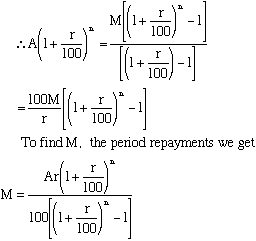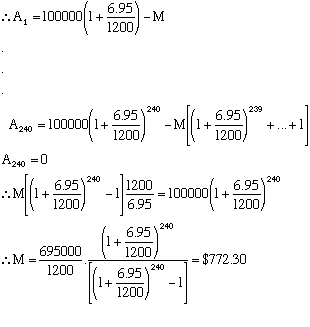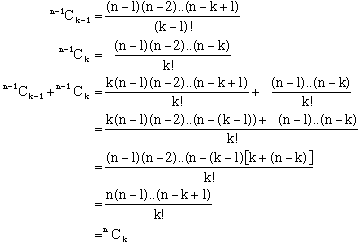 Review of Geometric Series
Review of Geometric Series
a, ar, ar2, ... , arn-1
is a GEOMETRIC SEQUENCE where a is the first term and r is the common ratio.
When these terms are summed or added together a GEOMETRIC SERIES is obtained.
![]()
Compound Interest
A useful application of the geometric sequence is for compound interest problems.
If an initial amount of money $P is invested at a compound interest rate of r % per period and if A1, A2 .. An are the accumulated amounts at the end of each period then
Ak + 1 = Ak + r/100. Ak = Ak(1 + r/100)
If A0 = initial amount = P then we see that
A1 = P(1 + r/100)
A2 = A1(1 + r/100) = P(1 + r/100)2
Thus deduce that :
Examples
Example One
$1000 is invested for two years at an annual rate of interest of 8% payable monthly.
How much is the investment worth at the end of the two years?
Here the period is a month
Therefore, n = 2 × 12 = 24
r = 8/12 = 2/3Using the compound interest formula above
A24 = 1000(1 + 2/300)24= $1173
Example Two
Suppose I deposit $100 at the start of each month into an account earning 7.5% per annum. Interest is compounded monthly. How much will I have in the account after 5 years?
Here we track the progress of each monthly deposit.
The first $100 is invested for 60 months and earns 7.5/12 % interest per month.
Therefore, Total = 100(1 + 7.5/1200)60 = A1The second amount is invested for 59 weeks
Therefore, A2 = 100(1 + 7.5/1200)59 etc.Therefore, Total = A1 + A2 + ... A60
= 100(1 + 7.5/1200)60 + ... + 100(1 + 7.5/1200)
= 100(1 + 7.5/1200)[(1 + 7.5/1200)59 + ... +1]
In the square brackets [ ] is a geometric series.
with a = 1 and r = (1 + 7.5/1200) and n = 60
= $7298
This example is typical of a superannuation fund type investment.
Time payments or Mortgages
A second application of geometric series to financial problems is in time payments ormortgages. They are also called "reducible interest loans" as interest is charged on a decreasing amount owed after each repayment.
Suppose $A is loaned to be repaid in equal instalments with an interest rate of r % per period being charged on money still owed.
Let the period repayment be $M
Let A1, A2 ,,, etc. be the amount still owing after each period.
Then A1 = A(1 + r/100) − M
A2 = A1(1 + r/100) − M
= A(1 + r/100)2 − M(1 + r/100) − M
Deduce An = A(1 + r/100)n − M(1 + r/100)n -1 − ... M(1 + r/100) − M
But An = 0 since loan now repaid.
Therefore, A(1 + r/100)n = M[(1 + r/100)n-1 + ... + (1 + r/100) + 1]
Again the [ ] contains a geometric series.

Note: Do not try to memorise this formula but work each problem following the steps of the derivation.
Example One
A $100 000 mortgage is to be repaid over 20 years in monthly instalments. The annual interest rate is 6.95% and is applied monthly.
Calculate the monthly repayments.
Here n = 20 × 12 = 240
r = 6.95/12
A = 100 000

Note: This means that total repayments are 240 × $772.3 = $185352.
Thus $85352 interest is paid!!!
Example Two
In the above example how much has been repaid after 10 years?
Let us calculate A120
![]()
= 199970 − 133306
= $66664 still owing
i.e. $33336 repaid.
Proofs By Induction
Suppose we have some statement S(n) depending on the positive integer n.
Let S = set of all positive integers for which S(n) is true.
Suppose we can prove the following:
(i) 1 is a member of S i.e. S(1) is true.
(ii) If all the positive integers 1, 2, ..., k are members of S then so is k+1.
i.e. S(1), S(2), ...S(k) are true then so is S(k + 1)
Then we may deduce that S(n) is true for all positive integers.
This process is called proof by induction.
Example
Prove S(n): ![]()
Proof 
Now assume S(1), S(2), ... S(k) are all true
specifically ![]()
Therefore, If we add (k+1) to both sides.
1 + 2 + ...+ k + (k + 1) = 1/2.k(k + 1) + (k + 1)
![]()
Therefore, S(k +1) is true
Therefore, The proof by induction is complete and ![]()
The proof works as follows:
If 1 ![]() S and (ii) has been proved then 1, 2
S and (ii) has been proved then 1, 2 ![]() S. In turn this allows us to deduce 1, 2, 3
S. In turn this allows us to deduce 1, 2, 3 ![]() S and so on without limit. In most examples you only need the assumption S(k) is true to deduce S(k + 1).
S and so on without limit. In most examples you only need the assumption S(k) is true to deduce S(k + 1).
|
Example One
|
Example Two Prove 7n + 2 is divisible by 3 for all positive integers. We can rewrite this as: Assume S(k): 7k + 2 = 3m is true. Consider 7k + 1 + 2 = 7k.7 + 2 Now if m is an integer so is 7m − 4 By induction 7n + 2 is always divisible by 3 |
In the theory of Binomial Expansions the coefficient of xk in the expansion (1 + x)n is written nCk
Therefore, (1 + x)n = nC0 + nC1 x + nC2 x2 + ... + nCn xn
Putting x = 0 gives nC0 = 1
Also the Pascal's Triangle theorem states that:
n -1Ck -1 + n -1Ck = nCk
This, together with induction can be used to prove
Therefore, true for n = 2
Assume the formula is true for all coefficients in the expansion of (1 + x)n − 1
In particular:

And this is known to be true by Pascal's Triangle
Therefore, If true for all coefficients in (1 + x)n also true for all coefficients in (1 + x)n
But proved for n = 1 and n = 2
Therefore, true for all positive integers.
Note:
Induction can be extended for use in proving statements based on any set with
(i) An initial value
(ii) Every member has a "next" element
e.g. S = {4, 5, 6, ...} all integers ≥ 4
S = {1/4, 1/2, 3/4, ..} all multiples of 1/4 ≥ 1/4
Induction cannot be used on sets of real numbers since a real number has no "next" element.


